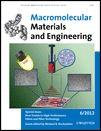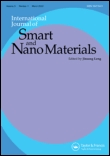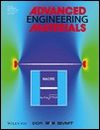
Advanced Materials Technologies
Scope & Guideline
Advancing Research for Tomorrow's Technologies
Introduction
Aims and Scopes
- Innovative Material Design and Fabrication:
The journal emphasizes the creation and optimization of new materials, including nanocomposites, hydrogels, and 2D materials, using advanced fabrication techniques such as 3D printing, inkjet printing, and electrospinning. - Multifunctional Devices and Applications:
A core focus is on developing materials for multifunctional devices, including sensors, actuators, and energy storage systems that can operate under various conditions and provide real-time data. - Biocompatibility and Biomedical Applications:
Research on materials that are biocompatible and can be used in medical applications, such as drug delivery systems, wearable health monitors, and tissue engineering scaffolds, is a significant area of interest. - Sustainability and Green Technologies:
The journal promotes research that explores sustainable materials and processes, including biodegradable materials and eco-friendly manufacturing techniques. - Advanced Characterization Techniques:
There is a strong emphasis on utilizing advanced characterization methods to understand the properties and performance of new materials, which is essential for their application in real-world scenarios.
Trending and Emerging
- Wearable and Flexible Electronics:
There is a significant increase in research related to wearable electronics, highlighting the demand for flexible materials that can seamlessly integrate with human physiology for health monitoring and other applications. - Energy Harvesting Technologies:
Emerging studies are focusing on innovative energy harvesting methods, particularly those utilizing triboelectric nanogenerators, to create self-powered devices that can operate independently of external power sources. - Smart and Responsive Materials:
Research on materials that can adapt to environmental stimuli—such as temperature, humidity, or pressure—is becoming increasingly popular, particularly for applications in soft robotics and smart textiles. - Nanomaterials and 2D Materials:
The exploration of nanomaterials and 2D materials, especially for applications in electronics and photonics, is gaining momentum, driven by their unique properties and potential for miniaturization. - Bioinspired Materials and Structures:
There is a growing interest in bioinspired designs and materials that mimic natural systems, leading to innovative solutions in various fields, including robotics, sensors, and energy storage.
Declining or Waning
- Traditional Manufacturing Techniques:
Research focused solely on conventional manufacturing methods appears to be waning, as there is a growing preference for additive manufacturing and other innovative fabrication techniques that offer greater flexibility and efficiency. - Single-Function Materials:
There has been a noticeable decline in studies centered on materials with single functionalities. The trend is moving towards multifunctional materials that can perform multiple tasks simultaneously. - Passive Sensing Technologies:
The focus on passive sensing technologies is decreasing, with a shift towards more active and responsive sensing technologies that integrate energy harvesting capabilities for real-time applications.
Similar Journals

Frontiers in Materials
Advancing the Future of Materials Science.Frontiers in Materials, an esteemed journal published by FRONTIERS MEDIA SA, is a leading platform in the field of Materials Science, with a notable impact factor placing it in the Q2 category of its discipline as of 2023. Since its establishment as an Open Access journal in 2014, it has fostered considerable academic exchange, allowing researchers from around the globe to share their innovative findings and insights. Based in Lausanne, Switzerland, this journal not only emphasizes high-quality peer-reviewed articles but also prioritizes rapid dissemination of research, as evidenced by its commendable Scopus ranking of #62 out of 196 in Materials Science (miscellaneous). By consistently striving to bridge the gap between academia and practical applications, Frontiers in Materials serves as an invaluable resource for researchers, professionals, and students seeking to delve into cutting-edge advancements and transformative applications in materials science.

MACROMOLECULAR MATERIALS AND ENGINEERING
Connecting Researchers in the World of Polymer EngineeringMACROMOLECULAR MATERIALS AND ENGINEERING, published by Wiley-VCH Verlag GmbH, is a distinguished open-access journal that since its inception in 1989 has been at the forefront of research in the fields of Chemical Engineering, Materials Chemistry, and Polymer Science. Recognized with a top-tier Q1 ranking in multiple categories for 2023, including Chemical Engineering and Organic Chemistry, this journal facilitates cutting-edge discoveries and advancements by providing a platform for authors to share innovative findings. With an impressive Scopus ranking, positioned within the top percentiles in several interdisciplinary categories, MACROMOLECULAR MATERIALS AND ENGINEERING is an essential resource for researchers, professionals, and students who are engaged in the development and application of macromolecular materials. As an open-access journal since 2023, it enhances accessibility and fosters collaboration within the global scientific community. The journal, headquartered in Germany, aims to publish high-quality, peer-reviewed articles that drive the scientific dialogue forward in the rapidly evolving fields of materials science and engineering.

International Journal of Smart and Nano Materials
Advancing the Future of Materials ScienceThe International Journal of Smart and Nano Materials is a leading peer-reviewed publication in the fields of civil and structural engineering, mechanics of materials, and materials science, published by Taylor & Francis Ltd. With its notable Open Access format since 2010, this journal aims to disseminate innovative research and advancements in smart materials and nano technologies, which are crucial for the development of sustainable and efficient engineering solutions. The journal has established a strong reputation, being classified in the Q1 category for Civil and Structural Engineering and Mechanics of Materials, and ranked highly in Scopus with impressive percentiles, illustrating its impact within the academic community. Covering research from 2010 to 2024, it serves as an essential resource for researchers, professionals, and students seeking to stay at the forefront of material innovation and engineering prowess. Current access options facilitate the broad distribution of knowledge, reflecting the journal's commitment to advancing scientific inquiry and application in an increasingly nanotechnology-driven world.

ADVANCED ENGINEERING MATERIALS
Unlocking the Potential of Innovative MaterialsADVANCED ENGINEERING MATERIALS is a leading journal dedicated to the field of materials science, particularly within the realm of condensed matter physics. Published by WILEY-V C H VERLAG GMBH in Germany, this esteemed journal has been a crucial platform for disseminating cutting-edge research since its inception in 1999. With an impressive impact factor and ranked in the top quartiles of its categories, it boasts a Q1 ranking in Condensed Matter Physics and a Q2 rank in related materials science fields as of 2023. ADVANCED ENGINEERING MATERIALS serves a diverse readership, including researchers, industry professionals, and students, striving to advance the understanding and application of innovative materials. Frequent contributions to this journal help bridge theoretical advancements with practical applications, fostering a vibrant academic and industrial dialogue. Although currently not an open-access journal, the insights shared within its pages are pivotal for anyone engaged in the dynamic sectors of engineering and material sciences.

Cailiao Gongcheng-Journal of Materials Engineering
Pioneering Discoveries in Materials EngineeringCailiao Gongcheng-Journal of Materials Engineering, published by the Beijing Institute of Aeronautical Materials (BIAM), is a prominent open-access journal dedicated to advancing the field of materials engineering. Since its inception in 1993, this journal has provided a platform for researchers and professionals to share innovative studies and findings within various subfields including aerospace engineering, metals and alloys, polymers and plastics, and surface engineering. With a commitment to open access since 2012, Cailiao Gongcheng ensures that research is accessible to a global audience, facilitating knowledge dissemination and collaboration. Ranking in the Q4 quartile across multiple categories, the journal serves as a vital resource for those invested in the latest developments and applications of materials technology. The journal's coverage extends up to 2024, reinforcing its relevance in an ever-evolving landscape of materials science.

AMERICAN CERAMIC SOCIETY BULLETIN
Fostering Excellence in Ceramic ScienceAMERICAN CERAMIC SOCIETY BULLETIN, published by the American Ceramic Society, serves as a pivotal publication in the field of ceramics and composites, highlighting research and advancements from 1969 to 1990, and resuming from 1993 to 2019, with a focus on the ongoing developments anticipated in 2023 and beyond. With an ISSN of 0002-7812 and an E-ISSN of 1945-2705, this journal stands out in its category, earning a respectable Q2 rank in the 2022 quartile rankings for Materials Science. Although not Open Access, its content remains essential for researchers, professionals, and students dedicated to exploring innovative materials and their applications. The journal's commitment to disseminating quality research fosters an informed community that drives the evolution of ceramics and composites, ensuring its readers stay at the forefront of this dynamic field.

Advanced Fiber Materials
Pioneering Discoveries in Advanced Fibrous MaterialsAdvanced Fiber Materials, published by SpringerNature, stands at the forefront of research in the realms of materials science, polymers, and optical and magnetic materials. With an ambitious scope that spans from 2019 to 2024, this journal is dedicated to disseminating cutting-edge findings and innovative applications in the field of advanced fibrous materials. It enjoys a prestigious status, classified in the Q1 quartile across several categories, including Electronic, Optical and Magnetic Materials and Materials Chemistry, showcasing its influence and relevance within the academic community. The journal's impressive rankings in Scopus highlight its significant contributions to the disciplines of Polymers and Plastics, as well as various aspects of Materials Science, consistently placing it among the top-tier publications in these fields. By encouraging open discourse among researchers, professionals, and students, Advanced Fiber Materials plays a crucial role in advancing knowledge and fostering innovation in material design and application.

Polymer-Plastics Technology and Materials
Exploring Innovations in Plastics TechnologyPolymer-Plastics Technology and Materials is a premier academic journal published by Taylor & Francis Inc., dedicated to the dynamic fields of chemical engineering, materials chemistry, and polymers and plastics. With an impact factor that reinforces its reputation, this journal is strategically indexed in Scopus, ranked notably within its categories (Q2), showcasing its influence and relevance in the academic community. Since its inception in 2019, the journal has served as an essential platform for researchers, professionals, and students to disseminate innovative studies and advancements in polymer science and materials technology. As an Open Access publication, it ensures that cutting-edge research is accessible to a global audience, fostering collaboration and knowledge sharing in the material sciences. Located in the United Kingdom, Polymer-Plastics Technology and Materials continues to enhance the dialogue within the industry, addressing critical challenges and exploring emerging trends that shape the future of polymer and plastics technologies.

ACS Nanoscience Au
Elevating Knowledge in NanotechnologyACS Nanoscience Au, published by the American Chemical Society, is a leading open-access journal dedicated to the rapidly evolving field of nanoscience. Since its inception in 2021, this journal has established itself within the top quartiles of academic publishing, ranking Q1 in both Chemistry and Materials Science for 2023. With a commitment to disseminating high-quality research, it provides a platform for innovative findings in nanomaterials, nanotechnology applications, and associated interdisciplinary studies. The journal is based in the United States and embraces an open-access model, ensuring that research is freely accessible to a global audience. This initiative not only enhances the visibility of authors' work but also facilitates collaboration across scientific domains. As a vital resource for researchers, professionals, and students alike, ACS Nanoscience Au plays a crucial role in advancing knowledge in the nanoscience community.

ACS Materials Letters
Transforming Ideas into Impactful InnovationsACS Materials Letters is an esteemed peer-reviewed journal published by the American Chemical Society, emphasizing groundbreaking research and advancements in the fields of materials science, biomedical engineering, and chemical engineering. With a robust update and established reputation since its inception in 2019, this journal has rapidly ascended to the top tiers, achieving Q1 rankings in key categories such as Biomedical Engineering, Chemical Engineering (miscellaneous), and Materials Science (miscellaneous) in 2023. The journal boasts impressive Scopus rankings, including #14 in General Chemical Engineering and #19 in Biomedical Engineering, placing it among the elite publications in these domains. While not fully open access, ACS Materials Letters facilitates the dissemination of high-impact research accessible to academics and industry professionals alike. With its comprehensive scope and rigorous selection process, the journal serves as a vital resource for researchers and students eager to stay abreast of the latest innovations and technologies shaping materials science and engineering.